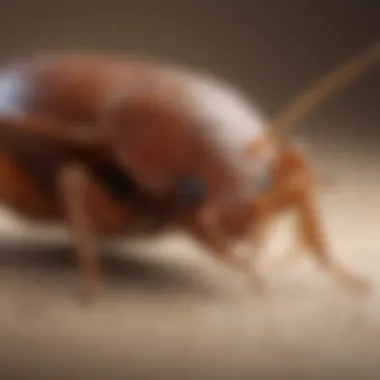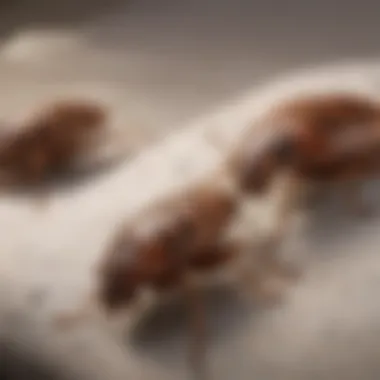Understanding the Physical Characteristics of Bed Bugs


Intro
Animal Overview
Common Name and Scientific Classification
The common name of this insect is the bed bug. Its scientific classification is Cimex lectularius. It belongs to the order Hemiptera, which also includes other pests like aphids and cicadas. Understanding its biological background helps in recognizing its traits and behaviors.
Physical Characteristics
Fully grown bed bugs are typically around 4 to 5 millimeters in length. Their bodies are flat, oval-shaped, and can appear reddish-brown in color. After feeding, their bodies swell and become more elongated due to the ingested blood.
Key features include:
- Size: Adult bed bugs measure between 4-5 mm in length, similar to an apple seed.
- Color: They usually exhibit a rusty or reddish-brown shade. Newly hatched nymphs are yellowish-white and become darker as they mature.
- Wings: Bed bugs do not have wings, which is unique compared to some other pest species.
- Antennas: They have long, segmented antennas that can be quite distinct.
Understanding these characteristics aids individuals in differentiating bed bugs from similar insects such as carpet beetles or fleas.
Habitat and Distribution
Bed bugs are found worldwide, thriving in urban areas where people gather. They prefer environments with close proximity to humans, often hiding in places like:
- Mattresses and bed frames
- Cracks and crevices in walls
- Upholstered furniture
They travel through personal belongings, luggage, and second-hand items, making awareness of their distribution key for prevention.
Behavior and Social Structure
Communication Methods
Bed bugs communicate primarily through pheromones. These chemical signals help them identify potential mates and recognize the presence of other bed bugs, contributing to their survival and reproduction in close quarters.
Social Hierarchies
While bed bugs display no clear social hierarchy, they can congregate in small groups, especially in their hiding spots. They are more active at night, hiding during the day and seeking hosts for feeding when it is dark.
Mating and Reproductive Behavior
Mating occurs via a process called traumatic insemination, where the male penetrates the female's abdomen to deposit sperm. A single female can produce hundreds of eggs in her lifetime, leading to rapid population growth if not managed effectively.
Conservation Status
Current Population Trends
Bed bugs have seen a significant resurgence in the past decades, largely due to increased international travel and urban living. Their adaptive nature allows them to thrive even in modern settings.
Threats and Challenges


Significant challenges arise from their resilience to many common pesticides, making elimination particularly difficult. Public misconceptions about their habitat and behaviors further complicate management efforts.
Conservation Efforts and Success Stories
While bed bugs are pests rather than endangered species, integrated pest management strategies have shown success in controlling their populations. Awareness campaigns and education about effective practices can reduce infestations.
Prologue to Bed Bugs
Bed bugs are small, blood-feeding insects that can prove to be a significant nuisance. Understanding their nature is crucial for controlling their presence effectively. This article addresses fundamental aspects of bed bugs to provide a thorough awareness of their characteristics.
By gaining knowledge about these pests, you can make informed choices about prevention and management. This understanding is especially valuable not only for families but also for professionals like veterinarians and wildlife biologists who may encounter bed bugs in various environments.
What Are Bed Bugs?
Bed bugs, scientifically known as Cimex lectularius, are small, wingless insects that thrive by feeding on blood. They are typically active at night and prefer to reside in close proximity to their hosts, often hidden in bedding, furniture, or cracks in walls. An adult bed bug is about the size of an apple seed, measuring approximately 5 to 7 mm in length.
These insects are known for their ability to reproduce quickly, making infestations a common issue, particularly in urban areas or settings where people frequently come and go, such as hotels.
History and Evolution
The evolution of bed bugs dates back thousands of years. They are believed to have originated in the Middle East and spread globally alongside human migration and trade. Ancient societies utilized various methods to control these pests, from using toxic plants to more modern approaches.
The resilience of bed bugs can be linked to their adaptive qualities. They have become resistant to many common pesticides, further complicating eradication efforts. The understanding of their history can provide context for current prevention and management strategies. By recognizing how bed bugs have developed in response to human behavior, we can better prepare ourselves against potential infestations.
Physical Characteristics of Fully Grown Bed Bugs
The physical characteristics of fully grown bed bugs are crucial for understanding and identifying these pests effectively. Recognizing features such as size, color, and shape enables individuals to differentiate bed bugs from other similar pests. This knowledge can expedite the response to infestations, ensuring timely and effective management strategies. Additionally, comprehension of these traits contributes to debunking common myths around bed bugs, further aiding education and prevention.
Size and Dimensions
Fully grown bed bugs typically reach a length of about 4 to 5 millimeters. This range may vary slightly, but generally, adult bed bugs are slightly larger than an apple seed. Their size makes them easily noticeable with careful inspection. Furthermore, the width of an adult bed bug is approximately 2 millimeters, flattened in shape. This unique dimension allows them to hide in narrow crevices, often making detection difficult.
Coloration and Texture
The coloration of fully grown bed bugs changes depending on their feeding status. After a blood meal, their bodies may appear reddish-brown due to the ingested blood. If unfed, they are a darker brown, somewhat resembling a toasted brown or mahogany shade. This variation in color plays a significant role in their camouflage, helping them blend into their surroundings.
The texture of a bed bug's body is smooth and slick, making it easier for them to move through their hiding spots. This sheen can make their bodies reflective under light, contributing to the difficulty in spotting them immediately. Different light conditions can affect visibility, which is important to consider during inspections.
Body Shape and Features
Fully grown bed bugs have an elliptical or oval body shape. Their bodies are flattened, which allows them to fit into tiny spaces. Each bed bug features a distinctive segmented abdomen that arcs upwards, giving them a characteristic appearance. The antennae are prominent, comprising four segments that can be observed easily upon closer inspection.
Additionally, bed bugs possess wings, but these are not functional for flight. Instead, they rely on crawling as their primary mode of movement. Their legs are long compared to their body size, aiding in quick movement when sensing threats or seeking hosts.
Understanding the physical characteristics of fully grown bed bugs is essential for both prevention and identification. Recognizing their size, color, and features can significantly improve management strategies.
Lifecycle Stages of Bed Bugs
Understanding the lifecycle stages of bed bugs is crucial for effective pest management and control. By grasping how these insects develop from one stage to another, individuals can recognize the signs of an infestation and respond accordingly. This knowledge not only aids in identification but also informs about the timing and methods of treatment needed to eliminate bed bugs before they proliferate.


Nymphs vs.
Adults
Bed bugs undergo several stages of development. They begin as eggs, hatch into nymphs, and eventually become fully grown adults. The nymphs are smaller versions of the adults, lacking mature reproductive organs. Their size difference can be quite striking; nymphs measure about 1.5 mm to 4.5 mm in length, while adults grow up to 5 to 7 mm or more.
Nymphs are almost translucent and can appear lighter in color, often blending into their surroundings. They require blood meals to molt and grow, shedding their outer skin around five times before reaching maturity. Recognizing nymphs is vital, as spotting them early can lead to quicker intervention before they become adults capable of reproduction.
Adult bed bugs are more easily visible. Their bodies are flat, oval-shaped, and reddish-brown after ingesting blood. They establish a reproductive cycle that can quickly lead to an infestation if not controlled. Generally, understanding the characteristics of nymphs helps in monitoring results of treatments and reassessing the pest's lifecycle in diverse environments.
Mating and Reproduction
Bed bugs reproduce in a manner called traumatic insemination, which is unique among insects. During this process, males penetrate the female's abdomen with their reproductive organ. After mating, females can lay up to five eggs per day, totaling around 200 to 500 in their lifetime.
The eggs themselves are small, measuring about 1 mm in length, and are typically placed in clusters in hidden areas, where they camouflage easily. They are pearly white and hatch within two weeks under ideal conditions.
A notable aspect of bed bug reproduction is the significant role that environmental factors play. Temperature and humidity can greatly influence egg development and the lifespan of bed bugs. An understanding of these reproductive patterns enables individuals to develop targeted strategies to interrupt the lifecycle and halt further infestations. This understanding can also guide effective management plans and inform clients on how to mitigate the spread of adults and nymphs within living spaces, ultimately protecting families and preserving public health.
In summary, recognizing the differences between nymphs and adults is essential while understanding their mating behaviors assists in effective control measures.
Common Misconceptions About Bed Bugs
Understanding common misconceptions about bed bugs is critical for effective identification and management. Many individuals mistakenly believe that bed bugs are always associated with poor hygiene or that they can be easily eliminated without professional help. These misconceptions can lead to delays in treatment, which may cause infestations to spread further.
When people assume that bed bugs are only found in dirty environments, they may overlook their presence in clean homes and establishments. This false narrative might prevent timely action, allowing populations to grow and making the problem worse.
In addition, some may think that common household insecticides are effective against bed bugs. In reality, many of these products are ineffective due to bed bugs' development of resistance over time. Several factors, including misidentification of the insects as other pests, can contribute to ineffective treatment approaches.
Identifying Bed Bugs vs.
Other Insects
Correctly distinguishing bed bugs from other similar-looking insects is essential. Bed bugs share resemblance with other pests like fleas and carpet beetles, leading to confusion. However, there are key identifying features for recognizing a bed bug:
- Shape: Bed bugs have a distinctive flat, oval shape, while other pests may be more elongated or rounded.
- Size: Fully grown bed bugs measure approximately 4 to 5 mm in length, which differentiates them from smaller insects like fleas.
- Coloration: Mature bed bugs are typically brown or reddish-brown, whereas some other pests might display different hues.
- Movement: Bed bugs move slowly compared to fleas that jump around quickly.
Furthermore, bed bugs do not have wings, while some insects in your home may.
Recognizing these factors improves the chances of appropriate interventions and treatments, which are vital in reducing the risk of widespread infestations.
Myths Surrounding Bed Bugs
Several myths about bed bugs contribute to the stigma surrounding them. One prevalent misconception is that bed bugs only infest beds. In truth, they can inhabit various spaces, including couches, carpets, and even behind wallpaper.
Another myth is that bed bugs spread diseases. While their presence is uncomfortable and can cause itching or skin reactions, bed bugs are not known to transmit any major illnesses. This fact can sometimes lessen fear, allowing individuals to approach infestations with a practical mindset.
Moreover, there is a belief that bed bugs are only a problem in certain geographical areas. This is not true. Infestations can occur anywhere in the world, regardless of cleanliness or locality.
Understanding and correcting these misconceptions ultimately aids in prevention and treatment efforts.


Implications of Bed Bug Infestations
Bed bug infestations can have notable implications for various stakeholders. Understanding these implications is crucial for effective management and prevention strategies. It is not just about the bugs themselves; the consequences extend to health, economic factors, and social aspects.
Health Risks Associated with Bed Bugs
Fully grown bed bugs are primarily known for their bites, which can lead to multiple health risks. The bites may cause discomfort and often result in itching, anxiety, and sleep disturbances. Some individuals might experience allergic reactions, leading to more severe symptoms. While bed bugs do not transmit diseases directly, secondary infections can occur due to scratching the bites. This could lead to more serious health complications.
Moreover, there is growing concern about the psychological impact of bed bug infestations. People may develop insomnia or anxiety because of the fear of being bitten. The stress of dealing with an infestation can affect one’s overall mental health. Thus, the health implications of bed bugs are not solely physical but also psychological.
"Health implications extend beyond bites; they encompass psychological stressors that affect one’s quality of life."
Economic Impact on Individuals and Businesses
The economic impact of bed bug infestations is substantial. For individuals, the costs associated with treatments, pest control services, and replacement of infested belongings can accumulate rapidly. Homeowners may spend hundreds to thousands of dollars to eliminate infestations effectively. Not only does this financial burden affect households, but businesses also feel the effects.
In commercial settings, especially in the hospitality industry, a bed bug infestation can lead to loss of revenue, bad reviews, and even legal implications. Hotels and restaurants must invest significantly in prevention and treatment to avoid damage to their reputation, which can take years to rebuild.
To summarize, the implications of bed bug infestations are serious. They range from health issues that impact daily life to economic burdens that individuals and businesses alike must navigate. Recognizing these implications helps in understanding the urgency of properly managing bed bug situations.
Prevention and Management Strategies
The appearance of fully grown bed bugs is only one part of the puzzle in managing infestations. Understanding prevention and management strategies is crucial to minimizing their impact. Knowledge of the physical traits of bed bugs aids in effective recognition; however, proactive measures are essential to avoid infestations entirely. Prevention is about creating barriers that inhibit bed bugs from entering your living spaces, while management focuses on reducing existing populations.
Detection Techniques for Bed Bugs
Detection is the first step in any effective management strategy. Some common techniques for identifying bed bugs include:
- Visual Inspection: Look under mattresses, bed frames, and furniture joints. Adult bed bugs are visible to the naked eye and can often be found in the seams of mattresses or cracks in the bed frame.
- Use of Monitoring Devices: These devices can help in detecting bed bugs. Traps and interception devices placed near beds can alert you if bed bugs are present.
- Chemical Detection: Certain canine units are trained to sniff out bed bugs. These dogs can often detect infestations faster than human inspections.
- Dust and Stain Evaluation: Look for black or brown spots on sheets, which may indicate bed bug feces. Dust in crevices can also provide clues about their presence.
Effective detection requires consistency and thoroughness. Early identification allows for swift action.
Effective Treatment Options
Managing an infestation requires a multi-faceted approach. Here are some effective treatment options available:
- Heat Treatment: Exposing the areas where bed bugs are found to high temperatures can be deadly to them. This method can be effective but needs specialized equipment.
- Chemical Treatments: Use insecticides approved for bed bug control. Products like pyrethroids target both nymphs and adults. Follow the manufacturer's instructions closely.
- Integrated Pest Management: This approach combines various effective methods like sanitation, monitoring, and chemical use to control bed bugs without solely relying on one method.
- Professional Extermination Services: Sometimes, the most effective strategy is hiring professionals. They have access to stronger products and advanced techniques to eliminate bed bugs safely and efficiently.
“Effective treatment is most successful when combined with proper detection techniques.”
Preventing and managing bed bug populations is crucial for maintaining health and comfort in living spaces. Both detection and effective treatments should be continuously refined as new methods and products become available. This requires staying informed and adapting strategies as needed.
Ending
Summary of Key Points
- Fully grown bed bugs are typically about the size of an apple seed, roughly 4 to 5 mm in length.
- Their color can range from a light brown to a deep reddish-brown, depending on their feeding status.
- Notable features include their flat, oval body shape and distinct segmented appearance.
- Misidentifying these pests can lead to ineffective treatment measures and increased infestation.
Call to Action for Awareness and Education
It is imperative for communities to prioritize education regarding bed bugs. Awareness of their appearance and habits can lead to better detection and faster response in case of an infestation. Consider educational programs that target schools and local health organizations to enhance knowledge.
Educating the public about bed bugs can significantly mitigate the risks associated with infestations. Simple actions can lead to effective management and prevention strategies.
Staying informed and vigilant will create a more proactive approach to combating bed bugs, ensuring healthier living spaces for everyone. Families, veterinarians, and wildlife biologists can play a vital role in spreading this awareness.







